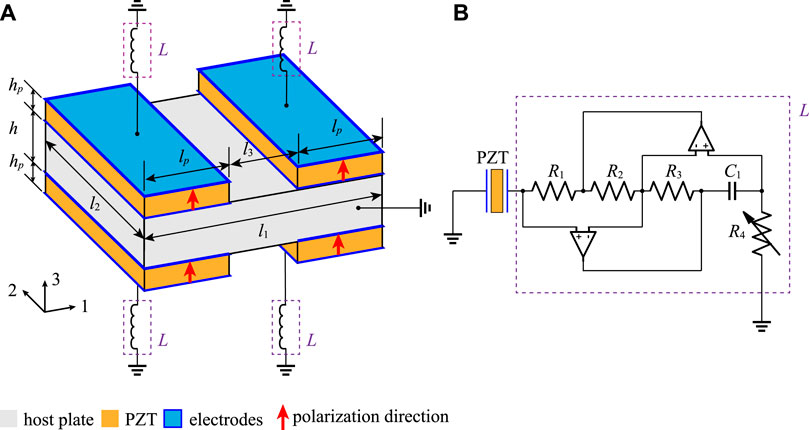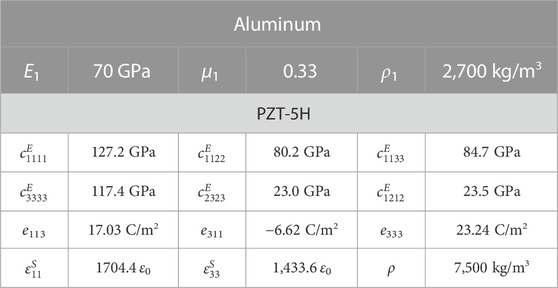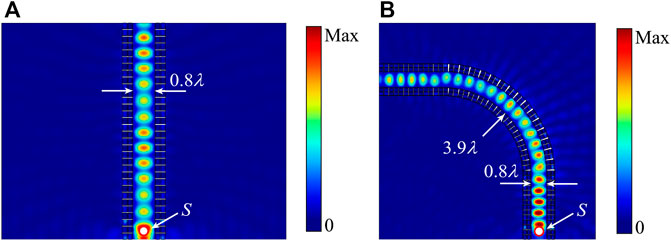- State Key Laboratory for Turbulence and Complex Systems, Department of Mechanics and Engineering Science, Peking University, Beijing, China
In this paper, a piezoelectric metasurface is proposed to manipulate the anti-symmetric mode Lamb wave by altering the diffraction order. The metasurface attached to a host plate is symmetrically arranged by out-of-plane polarized piezoelectric patches connected with synthetic inductance circuits. Without changing the physical configuration, the transmitted phase of the anti-symmetric mode Lamb wave can be shifted arbitrarily in 0 ∼ 2π range by the metasurface. Furthermore, the relationship between the phase gradient and diffraction order is investigated, and different orders of diffraction waves can be obtained by adjusting the shunting inductance circuits. The symmetric transmission and asymmetric transmission from a couple of axis symmetric incident waves can be realized by utilizing +1st-order and −1st-order diffraction. Moreover, omnidirectional wave reflection and wave trapping in channelized waveguides can also be realized by utilizing the 0th-order diffraction. The results indicate that the proposed piezoelectric metasurface has great potentials in manipulating guided waves with a large incident angle and isolating wave propagation.
1 Introduction
The wave control method based on wavefront-manipulated metasurface has attracted much attention owing to its capability of accurately adjusting the wave phase. Metasurfaces have been developed for manipulating electromagnetic waves [1, 2], acoustic waves [3, 4], and elastic waves [5, 6]. Based on the generalized Snell’s law (GSL) [7], the phase-gradient metasurface is designed to adjust the relationship between the wave vectors of scattering and incident waves for achieving abnormal functions, such as wavefront shaping [3, 4, 8], cloaking [9], mode conversion [10–12], and splitting [13].
According to the classical GSL, the incident wave should be within a critical angle to obtain a non-zero refracted wave. However, recent studies indicate that high-order-mode diffraction may occur when the incident angle is greater than the critical angle, which provides a new approach for manipulating acoustic waves [14, 15] and elastic waves [16] for negative refraction or reflection with broad angles [17–19], asymmetric transmission [20–24], wave absorption [25], wave isolation [26], and wave guiding [27]. These phenomena and functions have broken the limitation of the GSL. Therefore, the mechanism of high-order-mode diffraction should be explored for manipulating wave propagation far beyond the GSL.
Compared with the acoustic wave, guided waves in structures with multiple modes and complex dispersive nature bring big challenges to control wave propagation, and their different desired functions are realized by different configurations of metasurfaces. Based on +1st-order and −1st-order diffraction, Li et al. [24] fabricated two kinds of zigzag metasurfaces with different supercells, realizing the symmetric transmission and asymmetric transmission, respectively. Based on 0th-order diffraction, Liu et al. [26] designed a circular meta-slab to isolate the flexural waves by total reflection, Cao et al. [23] used a dual-layer elastic gradient metasurface to achieve the asymmetric transmission of flexural waves, and Hu et al. [27] realized the ultrathin waveguides using a channel bounded by two metasurfaces. The functionality of these metasurfaces depends on their diffraction orders. However, the diffraction order is determined by the fixed geometric configuration of the metasurface, whose diffraction order switching is difficult to realize. Moreover, for the metasurface based on the structural configuration, broadband application is hard to be achieved because the wave phase of the metasurface is sensitive to wavelength. Accordingly, it is urgent to introduce a tunable metasurface into the manipulation of high-order-mode diffraction, especially realizing the adjustment of diffraction order by the same metasurface.
Multi-physics coupling effect has good performance in tunable modulation of elastic waves without structural reconfiguration. Therefore, electromechanical coupling effects are favored by their capabilities of circuitry integration and controllability, whether in passive designs [28, 29] or active designs [30–36]. According to the GSL, when the metasurface is composed of PZT (lead zirconate titanate) patches connected with shunting circuits and is attached to the host plate, the tunable manipulations of anti-symmetric mode Lamb wave [37], shear horizontal wave [38], and multi-mode guided waves [39] in the plate can be realized by adjusting the parameters of the circuits. However, within severe constraints of the GSL, many fantastic performances of the metasurface cannot be realized. In addition, without changing the physical configuration, how to use the shunting circuit to achieve the control of diffraction order is still a key problem.
In this study, for conquering the limitation of the GSL on high-order diffraction, a tunable piezoelectric metasurface is proposed for controlling the anti-symmetric mode Lamb wave propagation with tunable diffraction order. The remainder of the paper is organized as follows: Section 2 introduces the integer parity design in the high-order-mode diffraction, and a metasurface that can control the diffraction order is further designed and investigated. To show the tunable control of diffraction orders, +1st, −1st, and 0th orders of diffraction are investigated as examples in the paper, and the corresponding special functions are investigated and exhibited in Section 3 and Section 4. In Section 3, the high-order anomalous refractions including symmetric transmission and asymmetric transmission are realized based on +1st and −1st orders of diffraction. Then, in Section 4, the omnidirectional reflection and channelized waveguides are realized based on 0th-order diffraction. Finally, Section 5 summarizes the paper and provides conclusions.
2 Modulation of diffraction order
2.1 Integer parity design
The distribution of phase-shift gradient is an important factor in the study of high-order-mode diffraction. Here, the phase shift is described as the difference in wave phases between the incident wave and the transmitted wave changed by the metasurface. By designing a phase-gradient metasurface, which is equivalent to a periodic lattice, the diffraction mechanism [17, 22] in the metasurface can be described as
where θinc is the angle of the incident wave, θtra/ref is the angle of the transmitted or reflected wave, k = 2π/λ is the wavenumber, λ is the wavelength (assuming that the incident area and transmitted area have the same medium), ξ is the phase gradient along the metasurface, nG is an integer which represents the effect of periodicity, and G is the lattice constant of reciprocal lattice. In Eq. 1, the phase gradient ξ can be expressed as ξ = dϕ/dx2, where ϕ is the phase shift and x2 is the coordinate axis along the metasurface. ξ can be assumed as positive because the positive and negative phase gradients are physically equivalent.
To simplify the design of the metasurface, a supercell with length S in the metasurface is introduced by including m functional units as shown in Figure 1A to realize the distribution of the phase gradient over a complete 0 ∼ 2π range. Therefore, the phase shift of the jth functional unit in the supercell is set at
where n = nG+1 is the diffraction order
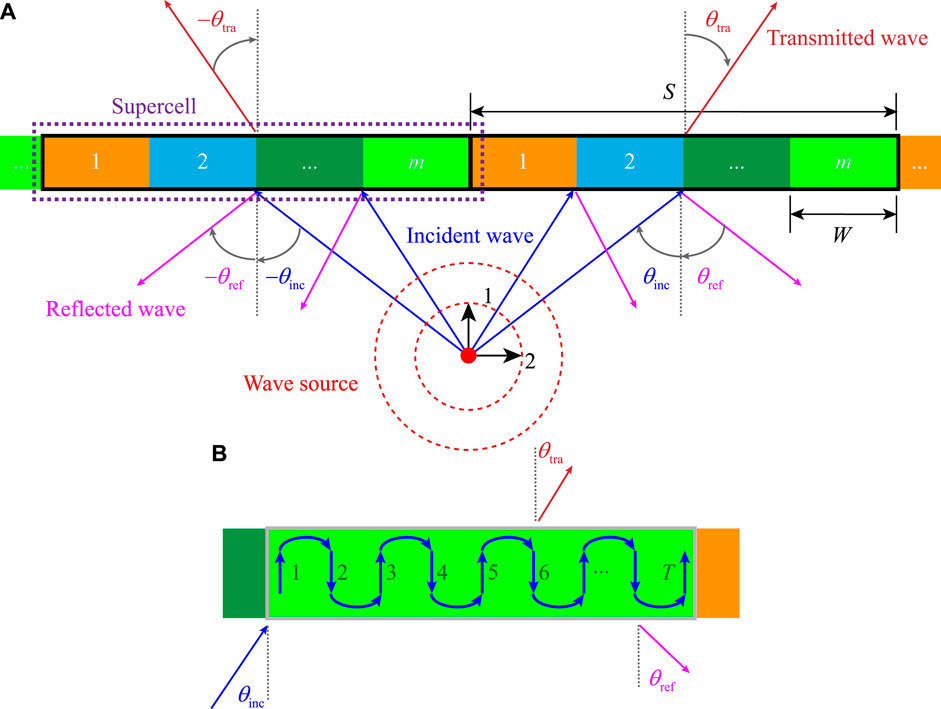
FIGURE 1. (A) Metasurface designed by supercells, and each supercell includes m functional units. (B) Wave propagation path in each functional unit.
For the case of n = 1, Eq. 2 can be reduced to the GSL. For the case of n ≠ 1, the wave diffraction can be described as the result of multiple reflections of the wave in the functional unit. Figure 1B illustrates the process of wave propagating in the functional unit for T times to reach its boundary. For example, if T = 1, it means that the incident wave passes through the functional unit directly as the transmitted wave. If T = 2, it means that the incident wave has one-time reflection in the functional unit and then leaves it at the incident side to be the reflected wave. Considering two adjacent functional units in the supercell, if both have (T−1) times inside reflections, the difference between their phase shifts becomes the cumulative phase of T-time wave propagation, that is,
For the case of n ≤ 0, the difference between phase shifts of two adjacent functional units can also be written as Δϕ′ = 2πn/m according to Eq. 2, which is the nth-order diffraction wave. Furthermore, the relationship of phase shifts between two adjacent functional units can be established by using the plane wave expression method as eiΔϕ = eiΔϕ′, that is,
If T is an odd number, the incident wave transmits through the supercell, and if T is an even number, the total reflection occurs. Consequently, by combining Eqs 2 and 3, the diffraction relation is summarized as
Therefore, the relationship between transmission/reflection of the wave and diffraction order n of the supercell is established by the wave propagating path, which is related to the addition of m and n. It means that the performance of wave propagation can be altered by changing the number of functional units m in a supercell or the diffraction order n.
2.2 Tunable capability of the piezoelectric functional unit
According to Eq. 4, the transmission or reflection of a wave can be controlled by the number of functional units m when the diffraction order n is determined. Actually, m and n are not independent in a strict sense. The applicable diffraction order of the existing metasurface is set by the distribution of the phase gradient in the supercell with fixed m. Recent studies [23–27] only used different structures of metasurfaces to realize different functional units m and then obtain the desired diffraction orders. In order to obtain a variable number m in the same metasurface, a basic functional unit based on the electromechanical coupling effect is designed by attaching PZT patches on both surfaces of the host plate as shown in Figure 2A. In the functional unit, four PZT patches (orange) with thin electrodes (blue) are symmetrically attached on both surfaces of the host plate (gray). To realize the manipulation of Lamb waves in the plate, each PZT patch is polarized along three directions [37], which are marked with red arrows in Figure 2A, and connected to an adjustable inductance L through the electrode on its surface. The effective capacitance of the PZT patch Cp and the shunting inductance L form a capacitance–inductance resonant system to alter the equivalent stiffness of the PZT patch [41, 42]. By adjusting the value of shunting inductance L, the equivalent stiffness of the PZT patch can be adjusted accordingly, and then the propagation of Lamb waves can be manipulated by the functional unit.
In fact, it is difficult to realize continuous adjustment of inductance using a real inductor. An adjustable synthetic inductor is achieved by using Antonio’s circuit [42] as shown in Figure 2B, which consists of two operational amplifiers, a capacitor (C1), three resistors (R1, R2, and R3), and an adjustable resistor (R4). The equivalent inductance of the synthetic circuit is induced by L = R1R3R4C1/R2, which is easily and continuously tuned by changing R4. The host plate in the functional unit is designed as l1 × l2 = 12 mm × 8 mm with the height h = 2 mm. The size of the PZT patch is lp × l2 × hp = 5 mm × 8 mm × 1 mm, and the gap between two PZT patches is l3 = 2 mm. The material parameters of the host plate (aluminum) and PZT patch (PZT-5H) are listed in Table 1, where the crystal symmetry of PZT-5H is 4 mm.
Without the loss of generality, the propagation of the anti-symmetric mode Lamb wave A0 in the aluminum plate is studied. To quantitatively evaluate the capability of a functional unit for manipulating A0-mode Lamb wave propagation, wave propagation in a host aluminum plate with one functional unit is considered, as shown in Figure 3A. To illustrate the propagation of the A0-mode Lamb wave in the plate, the incident A0-mode Lamb wave is excited at the left side of the functional unit, periodic boundary conditions are applied to both upper and lower sides of the host plate, and the perfectly matched layers (PMLs) are attached to both left and right sides of the host plate. The wave propagation process is calculated by the finite element method (FEM) via commercial software COMSOL Multiphysics. To obtain reliable calculation results, the functional unit is meshed by quadratic serendipity elements with a size smaller than one-tenth of the wavelength, and the mesh is appropriately encrypted near PZT patches. For the stable A0-mode Lamb wave excited at a frequency of 14 kHz with the wavelength λ = 0.037 m, the transmission ratio, which is described as the ratio of amplitudes of out-of-plane displacements (|w|) for the transmitted signal to the incident signal, and the phase shifts are calculated as the shunting inductance L changing from 0.095 H to 0.140 H as shown in Figure 3B. The results show that the phase shifts of the functional unit cover a full 0 ∼ 2π range, and the transmission ratio is relatively high (above 0.8). Consequently, the functional unit can be an elementary unit of the supercell to achieve an arbitrary phase shift in a 0 ∼ 2π range by only adjusting the shunting inductance. For a metasurface fabricated by a series of proposed functional units, the number of functional units m in a supercell can be changed by appropriately selecting the phase shift of each functional unit, and the supercell makes the diffraction order to be changeable in the same metasurface.
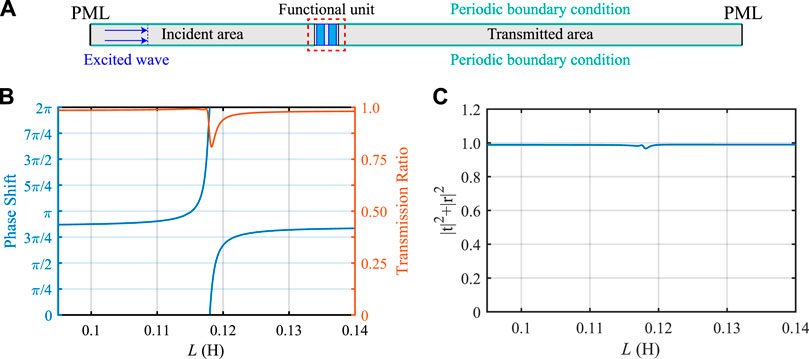
FIGURE 3. (A) Plate with one functional unit. (B) Phase shift and transmission ratio and (C) the sum of square of the transmission ratio and square of the reflection ratio of the A0-mode Lamb wave at frequency 14 kHz with varying L.
In addition, Figure 3C illustrates the sum of the square of the transmission ratio |t|2 and square of the reflection ratio (the ratio of |w| for the reflected signal to incident signal) |r|2 to show the energy loss of the A0-mode Lamb wave at frequency 14 kHz. The wave phase changes due to the local resonance of the PZT patch with a shunting circuit, which will inevitably consume energy. Therefore, the total energy is slightly less than 1, especially near the formant frequency. However, the sum is close to 1 with altering inductance L in general. It means that there is almost no strong energy loss and mode conversion of the wave by passing though the functional unit. Furthermore, the phase shifts, transmission ratios, and reflection ratios of the functional unit at an arbitrary frequency in the range from 10 to 30 kHz can also be calculated by FEM via commercial software COMSOL Multiphysics, and the effectivity of the functional unit to manipulate the A0-mode Lamb wave by adjusting the shunting inductance L is verified.
3 High-order anomalous refraction
To avoid the effect of higher order diffraction, the relation between the wavelength λ and the length of the supercell S should be
In addition, because the value of (sin θtra/ref − sin θinc) ranges from −2 to 2, according to Eq. 2, only three diffraction orders (n = +1, 0, − 1) exist for any incident angle. It is noteworthy that the 0th-order diffraction may occur, that is, θinc = θtra or θinc = θref. Eq. 3 indicates that, for the case of n ≤ 0, the 0th-order diffraction is the longest path. Hence, if other order diffraction waves exist, the amplitude of the 0th order diffraction wave is very small.
3.1 Symmetric transmission
If two A0-mode Lamb waves are incident with two opposite angles about the normal line of the metasurface, their transmitted angles are still opposite to each other, so they should satisfy the following condition:
and n1 = −n2, for realizing the symmetric transmission. Obviously, the symmetric transmission cannot be achieved by the GSL. Considering Eq. 5, only diffraction of +1st, −1st, and 0th orders exists in the metasurface, so that the diffraction orders of symmetric transmission in Eq. 6 are n1 = −n2 = 1. The incident wave with the negative incident angle −θinc is noted as NI and with the positive incident angle +θinc is noted as PI. Eq. 6 indicates that for the angles of NI and PI with axial symmetry about the normal line of the metasurface, their transmitted waves manipulated by the metasurface can have the axial symmetry and travel at the same side of incident waves.
According to Eq. 4, T = m + n should be an odd number to guarantee that the wave will transmit through the metasurface. For the critical incident angle of the +1st-order diffraction (GSL) θc1 = arcsin(1 − λ/S), the incident angle of NI should satisfy −θinc < θc1, while the angle of PI should satisfy +θinc > θc1 with the existence condition of −1st-order diffraction, −1 < sin(+θinc) − λ/S < 1.
There are 64 functional units to be arranged as the tunable metasurface in an aluminum plate as shown in Figure 3A for manipulating the A0-mode Lamb wave at frequency 14 kHz. An interval l4 = 0.001 m is set between all adjacent functional units to ensure that the phase shift modulation of the wave by each functional unit is independent and free from interference. Therefore, the length of the supercell can be obtained as S = m(l2+l4). When the difference in phase shifts between two adjacent functional units is π/2, a supercell needs four functional units, m = 4, to form the distribution of phase shifts in the range of 0 ∼ 2π as shown in Figure 4A, so the metasurface totally includes 16 supercells. In Figure 4A, the orange rectangles represent the functional units. The length of the supercell with four functional units as shown in Figure 4A is Sm=4 = 0.036 m, and it satisfies the condition expressed in Eq. 5. The critical angle of +1st-order diffraction is θc1 = −1.59°, which means that most of the incident angles can realize the symmetric transmission. For the incident angles of 30° and 15°, the transmitted angles θtra can be calculated by Eq. 6, and the values are 31.86° (θinc = 30°) and 50.26° (θinc = 15°), respectively. FEM is conducted to verify the analytical result, and the numerical results of out-of-plane displacement fields about incident and transmitted waves with NI and PI of 30° are shown in Figures 4B1, B2, respectively, while Figures 4C1, C2 show the results with NI and PI of 15°, respectively. The white arrows in Figures 4B, C point out the designed propagation directions of incident and transmitted waves. Compared with the displacement fields of wave motion, the propagation of refraction waves is in good agreement with designs. The results shown in Figures 4B, C illustrate that two incident angles with the same value but contrary signs can manipulate the refraction waves by the metasurface to transmit waves at the same sides along the designed transmitted angles with axial symmetry about the normal line of the metasurface.
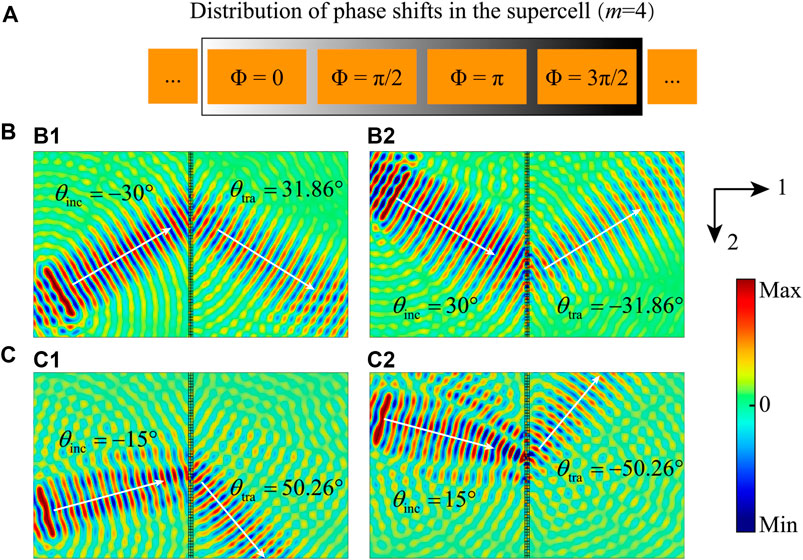
FIGURE 4. (A) Distribution of phase shifts along the supercell with m = 4. Out-of-plane displacement fields of (B) ± 30° and (C) ± 15° incident angles.
3.2 Asymmetric transmission
In general, for the angles of NI and PI with axial symmetry about the normal line of the metasurface, their transmitted waves manipulated by the metasurface can be without axial symmetry and propagate along arbitrary directions and are called as asymmetric transmission. Here, we consider one special case of generalized asymmetric transmission, which is that the angles of NI and PI have axial symmetry about the normal line of the metasurface; however, NI can pass through the metasurface, while PI is reflected by the metasurface. The corresponding condition for this case is
where n1 = 1 and n2 = −1 are the diffraction orders of NI and PI, respectively. In Eq. 7, the angles of NI and PI still have axial symmetry, and even the angles of transmitted/reflected waves maintain numerical axial symmetry. NI transmits through the metasurface following the GSL, and according to Eq. 3, T = m + n2 = m−1 should be an even number to make sure that the PI will be reflected by the metasurface. Figure 5A illustrates the distribution of phase shifts along the supercell with three functional units, m = 3. For manipulating the A0-mode Lamb wave at frequency 14 kHz, according to Eq. 5, the ratio λ/Sm=3 = 1.370 makes sure that only −1st, +1st, and 0th orders of diffraction can exist in the metasurface. The critical angle of the +1st-order diffraction can be calculated as θc1 = −21.74°. Different from the symmetric transmission of NI and PI in the supercell with m = 4, the limitation to the incident angle should be considered to realize asymmetric transmission. If the incident angle is smaller than θc1 = −21.74°, according to Eq. 7, only n1 = n2 = 0 satisfies the diffraction equations and only reflected waves occur for both NI and PI.
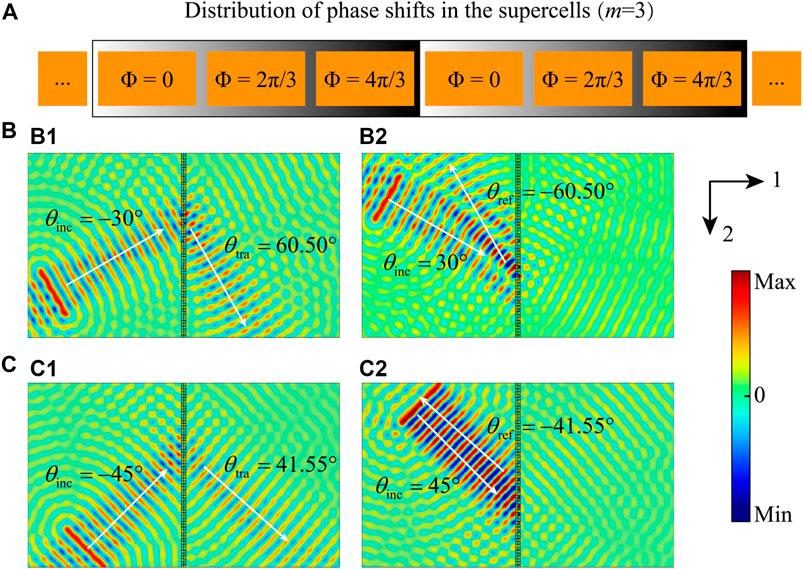
FIGURE 5. (A) Distribution of phase shifts along the supercell with m = 3. Out-of-plane displacement fields of (B) ± 30° and (C) ± 45° incident angles.
Figures 5B, C show the out-of-plane displacement fields of A0-mode Lamb waves calculated by FEM for the cases with the NI and PI angles of 30° and 45°, respectively. The transmitted or reflected angles θtra/ref of both cases can be calculated according to Eq. 7 to be 60.50° (θinc = 30°) and 41.55° (θinc = 45°), respectively. The white arrows in Figures 5B, C illustrate the designed propagation directions of waves, and the results are in good agreement with the designed angles. In Figures 5B1, B2, the angles of NI and PI are axial symmetry with 30°, but for the NI in Figure 5B1, the wave transmits through the metasurface with the designed angle 60.50°, while for the PI in Figure 5B2, the wave reflects backward by the metasurface with the designed angle −60.50°. The same tendency can be observed by the NI and PI cases of axial symmetry with angle 45° in Figures 5C1, C2. In addition, there are very low fluctuations to be observed in Figures 4B, C, 5B, C. There are two reasons that cause the chaotic disturbance. One is because the phase gradient of the realistic metasurface is discrete, so a few waves directly pass through the metasurface. The other one is because the 0th-order diffraction still exists in the symmetric and asymmetric transmissions based on +1st- and −1st- orders of diffraction but with negligible low amplitudes.
It should be noted that the transmission of NI and reflection of PI in asymmetric transmission are determined for the positive phase gradient. Their functions can be exchanged when the sign of the phase gradient is inverted, which is also applied in symmetric transmission. The symmetric and asymmetric transmissions are realized by the same metasurface based on the tunability of diffraction orders. It also means that the function is tunable to meet different demands and conquer the main drawback of the existing metasurfaces.
4 Omnidirectional reflection and channelized waveguides
4.1 Omnidirectional reflection
In Section 3, the relation between wavelength and length of the supercell is restricted by Eq. 5 to avoid the generation of higher order diffraction in the metasurface. The 0th-order diffraction has the longest path among all the diffraction orders with n ≤ 0 in the same supercell according to Eq. 3. Thus, if the 0th-order diffraction is used for designing the metasurface with a higher amplitude, all the other order diffraction should be suppressed. Based on Eq. 2, the supercell should be designed to satisfy the condition of λ/S > 2 to make sure that no diffraction wave exists except n = 0. As an example, for the A0-mode Lamb wave at frequency 14 kHz, the supercell with two functional units, m = 2, can satisfy the condition λ/Sm=2 = 2.06 > 2. Accordingly, when n = 0, T = m + n = 2 is an even number and Eq. 4 becomes sin θinc = sin θref, which means that the wave only reflects directly along the same angle as the incident one no matter which angle the incident wave is. Therefore, the omnidirectional reflection wave is easily realized by the 0th-order diffraction.
For the supercell with two functional units, m = 2, the distribution of phase shifts is illustrated in Figure 6A. There are three cases of A0-mode Lamb waves at frequency 14 kHz with the angles of NI as 0°, 30°, and 60°, respectively, to be calculated by FEM, and their out-of-plane displacement fields are shown in Figure 6B. The white arrows in Figure 6B mark the designed directions of incident waves and reflected waves. The results in Figure 6B are in good agreement with the designed arrows and show nearly total reflections in these cases.
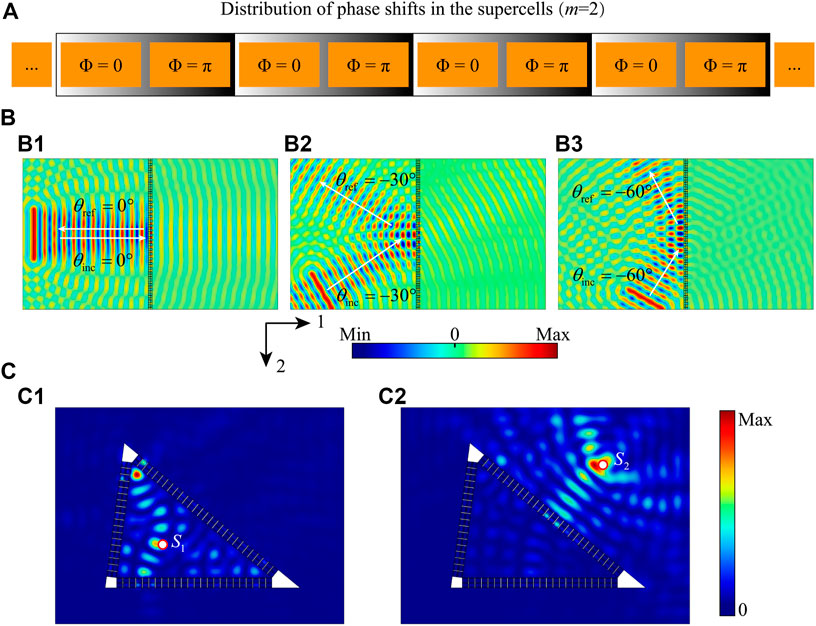
FIGURE 6. (A) Distribution of phase shifts along the supercell with m = 2. (B) Out-of-plane displacement fields of 0°, −30°, and −60° incident angles. (C) Energy field when a point source is placed inside and outside the triangle-shaped metasurface.
To further demonstrate that wave reflection is independent of the incident angle, a triangle-shaped metasurface is constructed by the supercell with m = 2. A point source (S1) is placed in a random position inside the triangle-shaped metasurface, and the energy field (represented by |w|2) is shown in Figure 6C1. The result shows that the wave energy is enclosed in the triangle, and no wave is transmitted anywhere outside the triangle. When the point source (S2) is moved outside the triangle-shaped metasurface, the wave energy can be isolated by the triangle as the energy field (|w|2) as shown in Figure 6C2. Therefore, the metasurface with the capability of omnidirectional reflection can make the wave energy to be concentrated inside the structure or isolated outside the structure, which exhibits exciting prospects for wave isolation.
4.2 Channelized waveguide
The supercell with m = 2 shows the strong ability to reflect the wave energy with an arbitrary incident angle. To deeply utilize the property, a channel is constructed by two metasurfaces as the route for wave propagation. When the wave propagates in the channel, it will be reflected by the metasurface boundary regardless of the incident angle. The channel can provide only one way for the wave to travel, despite its shape, that is, straight or curved. Figure 7 shows two examples of channelized waveguides for the A0-mode Lamb wave at frequency 14 kHz: one is a straight line and the other is in “L” shape. Figure 7A shows the energy field of out-of-plane displacement (|w|2) in a straight channel formed by metasurfaces based on the supercell with m = 2. The white dot with a red circle marks the location of the wave source. The width of the channel is selected smaller than the wavelength as 0 .8λ to avoid the generation of wave interference [27]. The result shows that the wave is trapped in the channel and propagates straight forward. If the channel is turned to form an “L”-shaped channel by metasurfaces, the energy field shows that the wave travels through the channel with high amplitude as shown in Figure 7B. Therefore, for two metasurfaces with omnidirectional reflection using the 0th-order diffraction, different shapes of waveguides can be designed to realize wave propagation along any designed route in the plate.
5 Conclusion
In this paper, a tunable piezoelectric metasurface is introduced to manipulate anomalous transmission and reflection of the anti-symmetric mode Lamb wave for achieving specific functions. The functional unit of the metasurface is symmetrically attached to piezoelectric patches with shunting inductance circuits on the host plate, and its phase shift can be arbitrarily tuned in the range of 0 ∼ 2π with wide frequency by adjusting the shunting inductance circuits. Without changing the physical configuration of the piezoelectric metasurface, the functional unit number of a supercell in the metasurface can be flexibly reprogrammed by properly adjusting the shunting inductance circuits for the desired phase shift distribution, and it can meet different requirements of manipulating wave propagation by the design and utilization of different orders of diffraction. Four kinds of exceptional functions are realized by tuning the diffraction orders in the metasurface. By utilizing the +1st-order and −1st-order diffraction, a couple of axis symmetric incident waves can achieve two functions: one is the symmetric transmission to obtain two transmitted waves with axis symmetry, and the other one is the asymmetric transmission to produce two separate transmitted and reflected waves with the same angle but contrary sign. By utilizing the 0th-order diffraction, the omnidirectional reflection can be achieved and arbitrary channelized waveguides can be designed. Similarly, other specific functions with higher order diffraction can also be realized by the same metasurface. Consequently, this proposed metasurface can promote the research beyond generalized Snell’s law by adjusting the shunting inductance circuits to achieve tunable high-order diffraction, and it has robustness, intelligence, and multifunctionality for manipulation of wave propagation. The metasurface has exhibited fair prospects of potential applications in wave motion control, wave isolation, and other fields.
Data availability statement
The original contributions presented in the study are included in the article/Supplementary Material. Further inquiries can be directed to the corresponding author.
Author contributions
SS: conceptualization, methodology, software, validation, visualization, and writing—original draft. JC: validation and visualization. RX: software, validation, and writing—review and editing. ZL: conceptualization, funding acquisition, supervision, and writing—review and editing.
Funding
This work was supported by the National Natural Science Foundation of China under Grant Nos 11890681 and 12172008.
Conflict of interest
The authors declare that the research was conducted in the absence of any commercial or financial relationships that could be construed as a potential conflict of interest.
Publisher’s note
All claims expressed in this article are solely those of the authors and do not necessarily represent those of their affiliated organizations, or those of the publisher, the editors, and the reviewers. Any product that may be evaluated in this article, or claim that may be made by its manufacturer, is not guaranteed or endorsed by the publisher.
References
1. Aieta F, Genevet P, Yu N, Kats MA, Gaburro Z, Capasso F. Out-of-plane reflection and refraction of light by anisotropic optical antenna metasurfaces with phase discontinuities. Nano Lett (2012) 12:1702–6. doi:10.1021/nl300204s
2. Yu N, Capasso F. Flat optics with designer metasurfaces. Nat Mater (2014) 13:139–50. doi:10.1038/nmat3839
3. Li Y, Liang B, Gu ZM, Zou XY, Cheng JC. Reflected wavefront manipulation based on ultrathin planar acoustic metasurfaces. Scientific Rep (2013) 3:2546. doi:10.1038/srep02546
4. Li Y, Jiang X, Liang B, Cheng JC, Zhang L. Metascreen-based acoustic passive phased array. Phys Rev Appl (2015) 4:024003. doi:10.1103/PhysRevApplied.4.024003
5. Zhu H, Semperlotti F. Anomalous refraction of acoustic guided waves in solids with geometrically tapered metasurfaces. Phys Rev Lett (2016) 117:034302. doi:10.1103/PhysRevLett.117.034302
6. Liu Y, Liang Z, Liu F, Diba O, Lamb A, Li J. Source illusion devices for flexural Lamb waves using elastic metasurfaces. Phys Rev Lett (2017) 119:034301. doi:10.1103/PhysRevLett.119.034301
7. Yu N, Genevet P, Kats MA, Aieta F, Tetienne JP, Capasso F, et al. Light propagation with phase discontinuities: Generalized laws of reflection and refraction. Science (2011) 334:333–7. doi:10.1126/science.1210713
8. Qiu H, Li F. Manipulation of shear horizontal guided wave with arbitrary wave fronts by using metasurfaces. J Phys D: Appl Phys (2020) 53:285301. doi:10.1088/1361-6463/ab850d
9. Li H, Hou Z, Pei Y. The holographic algorithm and design for propagation of flexural Lamb waves and particles manipulation using elastic metasurfaces. Extreme Mech Lett (2022) 54:101765. doi:10.1016/j.eml.2022.101765
10. Kim MS, Lee WR, Kim YY, Oh JH. Transmodal elastic metasurface for broad angle total mode conversion. Appl Phys Lett (2018) 112:241905. doi:10.1063/1.5032157
11. Lee SW, Seung HM, Choi W, Kim M, Oh JH. Broad-angle refractive transmodal elastic metasurface. Appl Phys Lett (2020) 117:213502. doi:10.1063/5.0026928
12. Li X, Chen Y, Zhang X, Huang G. Shaping elastic wave mode conversion with a piezoelectric-based programmable meta-boundary. Extreme Mech Lett (2020) 39:100837. doi:10.1016/j.eml.2020.100837
13. Su X, Lu Z, Norris AN. Elastic metasurfaces for splitting SV- and P-waves in elastic solids. J Appl Phys (2018) 123:091701. doi:10.1063/1.5007731
14. Assouar B, Liang B, Wu Y, Li Y, Cheng JC, Jing Y. Acoustic metasurfaces. Nat Rev Mater (2018) 3:460–72. doi:10.1038/s41578-018-0061-4
15. Park JH, Ma PS, Lee HJ. Integrated acoustic multilayer metasurfaces for high degree of diffractive functionality. Int J Mech Sci (2022) 233:107653. doi:10.1016/j.ijmecsci.2022.107653
16. Cao L, Yang Z, Xu Y. Steering elastic SH waves in an anomalous way by metasurface. J Sound Vib (2018) 418:1–14. doi:10.1016/j.jsv.2017.12.032
17. Xie Y, Wang W, Chen H, Konneker A, Popa BI, Cummer SA. Wavefront modulation and subwavelength diffractive acoustics with an acoustic metasurface. Nat Commun (2014) 5:5553. doi:10.1038/ncomms6553
18. Liu B, Zhao W, Jiang Y. Apparent negative reflection with the gradient acoustic metasurface by integrating supercell periodicity into the generalized law of reflection. Sci Rep (2016) 6:38314. doi:10.1038/srep38314
19. Liu B, Zhao W, Jiang Y. Full-angle negative reflection realized by a gradient acoustic metasurface. AIP Adv (2016) 6:115110. doi:10.1063/1.4967430
20. Shen C, Xie Y, Li J, Cummer SA, Jing Y. Asymmetric acoustic transmission through near-zero-index and gradient-index metasurfaces. Appl Phys Lett (2016) 108:223502. doi:10.1063/1.4953264
21. Li Y, Shen C, Xie Y, Li J, Wang W, Cummer SA, et al. Tunable asymmetric transmission via lossy acoustic metasurfaces. Phys Rev Lett (2017) 119:035501. doi:10.1103/PhysRevLett.119.035501
22. Fu Y, Shen C, Cao Y, Gao L, Chen H, Chan CT, et al. Reversal of transmission and reflection based on acoustic metagratings with integer parity design. Nat Commun (2019) 10:2326. doi:10.1038/s41467-019-10377-9
23. Cao L, Xu Y, Assouar B, Yang Z. Asymmetric flexural wave transmission based on dual-layer elastic gradient metasurfaces. Appl Phys Lett (2018) 113:183506. doi:10.1063/1.5050671
24. Li B, Hu Y, Chen J, Su G, Liu Y, Zhao M, et al. Efficient asymmetric transmission of elastic waves in thin plates with lossless metasurfaces. Phys Rev Appl (2020) 14:054029. doi:10.1103/PhysRevApplied.14.054029
25. Cao L, Yang Z, Xu Y, Fan SW, Zhu Y, Chen Z, et al. Flexural wave absorption by lossy gradient elastic metasurface. J Mech Phys Sol (2020) 143:104052. doi:10.1016/j.jmps.2020.104052
26. Liu F, Shi P, Xu Y, Cao L, Shen Y, Yang Z. Total reflection of flexural waves by circular meta-slab and its application in vibration isolation. Int J Mech Sci (2021) 212:106806. doi:10.1016/j.ijmecsci.2021.106806
27. Hu Y, Zhang Y, Su G, Zhao M, Li B, Liu Y, et al. Realization of ultrathin waveguides by elastic metagratings. Commun Phys (2022) 5:62. doi:10.1038/s42005-022-00843-0
28. Xia R, Zhu J, Yi J, Shao S, Li Z. Guided wave propagation in multilayered periodic piezoelectric plate with a mirror plane. Int J Mech Sci (2021) 204:106539. doi:10.1016/j.ijmecsci.2021.106539
29. Xia R, Shao S, Yi J, Zheng K, Negahban M, Li Z. Tunable asymmetric transmission of Lamb waves in piezoelectric bimorph plates by electric boundary design. Compos Struct (2022) 300:116111. doi:10.1016/j.compstruct.2022.116111
30. Li X, Chen Y, Hu G, Huang G. A self-adaptive metamaterial beam with digitally controlled resonators for subwavelength broadband flexural wave attenuation. Smart Mater Struct (2018) 27:045015. doi:10.1088/1361-665X/aab167
31. Kumar S, Pueh Lee H. Recent advances in active acoustic metamaterials. Int J Appl Mech (2019) 11:1950081. doi:10.1142/S1758825119500819
32. Li X, Chen Y, Zhu R, Huang G. An active meta-layer for optimal flexural wave absorption and cloaking. Mech Syst Signal Process (2021) 149:107324. doi:10.1016/j.ymssp.2020.107324
33. Yi J, Ma Z, Xia R, Negahban M, Chen C, Li Z. Structural periodicity dependent scattering behavior in parity-time symmetric elastic metamaterials. Phys Rev B (2022) 106:014303. doi:10.1103/PhysRevB.106.014303
34. Wu Q, Shivashankar P, Xu X, Chen Y, Huang G. “Multifunctional composites for autonomic, adaptive and self-sustaining systems”. Engineering nonreciprocal wave dispersion in a nonlocal micropolar metabeam. J Compos Mater (2022) 002199832211405. doi:10.1177/00219983221140562
35. Wu Q, Zhang X, Shivashankar P, Chen Y, Huang G. Independent flexural wave frequency conversion by a linear active metalayer. Phys Rev Lett (2022) 128:244301. doi:10.1103/PhysRevLett.128.244301
36. Ma F, Wang C, Liu C, Wu JH. Structural designs, principles, and applications of thin-walled membrane and plate-type acoustic/elastic metamaterials. J Appl Phys (2021) 129:231103. doi:10.1063/5.0042132
37. Li S, Xu J, Tang J. Tunable modulation of refracted lamb wave front facilitated by adaptive elastic metasurfaces. Appl Phys Lett (2018) 112:021903. doi:10.1063/1.5011675
38. Xia R, Yi J, Chen Z, Li Z. In situ steering of shear horizontal waves in a plate by a tunable electromechanical resonant elastic metasurface. J Phys D: Appl Phys (2020) 53:095302. doi:10.1088/1361-6463/ab5cbc
39. Shao S, Xia R, Li Z. Tunable piezoelectric metasurface for manipulating multi-mode guided waves in plate. Eng Struct (2022) 270:114917. doi:10.1016/j.engstruct.2022.114917
41. Hagood N, von Flotow A. Damping of structural vibrations with piezoelectric materials and passive electrical networks. J Sound Vib (1991) 146:243–68. doi:10.1016/0022-460X(91)90762-9
Keywords: metasurface, Lamb wave, diffraction, piezoelectricity, metamaterials, anomalous refraction
Citation: Shao S, Chen J, Xia R and Li Z (2023) Lamb waves manipulation by piezoelectric metasurface with tunable diffraction orders. Front. Phys. 10:1114544. doi: 10.3389/fphy.2022.1114544
Received: 02 December 2022; Accepted: 28 December 2022;
Published: 16 January 2023.
Edited by:
Zongliang Du, Dalian University of Technology, ChinaReviewed by:
Xiaopeng Li, Toyota Research Institute of North America, United StatesFuyin Ma, Xi’an Jiaotong University, China
Copyright © 2023 Shao, Chen, Xia and Li. This is an open-access article distributed under the terms of the Creative Commons Attribution License (CC BY). The use, distribution or reproduction in other forums is permitted, provided the original author(s) and the copyright owner(s) are credited and that the original publication in this journal is cited, in accordance with accepted academic practice. No use, distribution or reproduction is permitted which does not comply with these terms.
*Correspondence: Zheng Li, bGl6aGVuZ0Bwa3UuZWR1LmNu
 Shixuan Shao
Shixuan Shao Jiyue Chen
Jiyue Chen Rongyu Xia
Rongyu Xia Zheng Li
Zheng Li